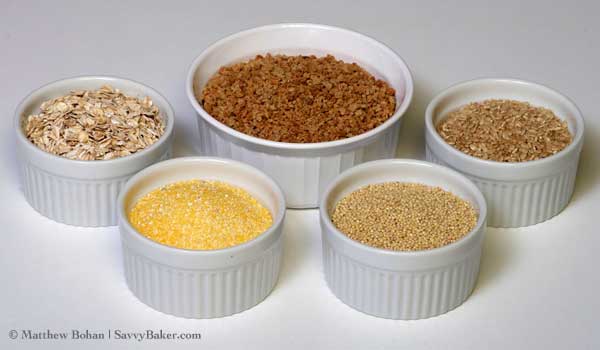Why Is It Important to Eat Whole Grains?
Studies have shown that eating whole grains instead of refined has been linked to…
a reduced risk of coronary heart disease,
a decreased risk for type 2 diabetes,
a reduced risk of asthma,
improved weight management,
improved digestive health, including the prevention of constipation,
reduced instances of gum disease,
better blood pressure levels,
and, not surprisingly, longevity.
What Are Whole Grains?
Whole grains and foods made from whole grains contain all of the essential parts and naturally-occurring nutrients of the entire grain seed. If the grain has been processed (e.g., cracked, crushed, rolled, extruded, and/or cooked), the food product should still deliver roughly the same balance of nutrients found in the original grain seed.
More specifically, whole grains contain bran and germ as well as the endosperm. Refined grains have been milled, a process that removes the bran and germ, leaving only the endosperm. This gives grains a finer texture and improves their shelf life, but it also removes dietary fiber, iron and many B vitamins.
Did You Know?
Adults should eat at least three to five servings of whole grains each day.
Children should have at least two to three servings of whole grains per day.
The average American eats less than one daily serving of whole grains, with more than 40% of Americans not eating any whole grains.
One serving, or a one-ounce equivalent, of whole grains…
= 1 slice of whole wheat bread
= 1 whole wheat mini bagel (a large bagel = 4 servings!)
= 1 cup of whole wheat or toasted oat ready-to-eat cereal (flakes or rounds)
= 1/2 cup of whole-grain cooked cereal
= 1/2 cup cooked whole wheat pasta (1 oz. dry)
= 1 whole wheat or buckwheat pancake (4 1/2″) or 2 small ones (3″)
= 1 small whole wheat muffin (just 2 1/2″ in diameter)
= 5 whole wheat crackers
= 1 small whole wheat or whole-grain corn tortilla (6″)
= 1/2 cup cooked brown rice
= 1/2 cup cooked whole wheat couscous
= 1/2 cup cooked wild rice
Examples of Whole Grains
Barley, including Hulled, Dehulled, Pot and Scotch (not Pearl)
Brown Rice
Cornmeal, whole
Oats
Millet
Rye
Sorgum
Teff
Triticale
Wheat, including Whole Wheat Berries and Bulgur (Cracked Wheat)
Examples of Seeds Regarded as Whole Grains
Amaranth
Buckwheat
Quinoa
Wild Rice
Examples of Whole-grain Products
Oat Groats, Rolled Oats and Steel-cut Oats
Popcorn
Whole Wheat Bread, Whole Wheat Crackers, Whole Wheat Pasta and Whole Wheat Tortillas
Examples of Products Typically Made with Refined Grains*
Cornbread
Corn Tortillas
Couscous
Crackers
Flour Tortillas
Grits
Pasta, such as Spaghetti and Macaroni
Pitas
Pretzels
Ready-to-eat Breakfast Cereals, such as Corn Flakes
White Bread
White Sandwich Buns and Rolls
White Rice
* Check the label. Foods labeled with the words multi-grain, stone-ground, 100% wheat, cracked wheat, seven-grain, or bran are often not whole-grain products. Instead, choose those that name one of the following whole-grain ingredients first on the ingredient list: brown rice, bulgur, graham flour, oatmeal, whole-grain corn, whole oats, whole rye, whole wheat or wild rice.
Sources and Additional Resources
Tips to Help You Eat Whole Grains, MyPyramid.gov
Inside the Pyramid, MyPyramid.gov
The Nutrition Source: Health Gains from Whole Grains, Harvard School of Public Health
The Whole Grain Guide, Nutrition Action Health Letter
A whole-grain glossary, Twenty whole grains to cook and eat, Culinate.com
Whole grains: Hearty options for a healthy diet, MayoClinic.com
Whole Grains 101, Whole Grains Council
© Liesl K. Bohan | SavvyBaker.com
